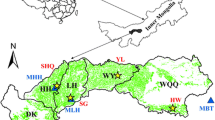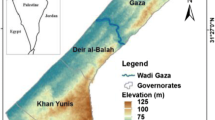Abstract
In the Federal State of Brandenburg, the average temperature is expected to increase by about 4.4 °C by 2100 due to climate change. In addition, precipitation is expected to decrease by about 200 mm, consequently the climatic water balance deficit will increase to 420 mm. Brandenburg is mainly characterised by morainic sandy soils with a low soil water storage capacity. All this will limit the amount of plant-available water during spring and summer months, increasing the cropping risk, especially for spring crops, and reducing crop yields as well as yield stability. This paper outlines the ZUWABE model for estimating the irrigation water demands of agricultural crops, which was developed in ZALF Müncheberg, Germany. It can be used for spatial simulation under past, present and future climate conditions. For all agricultural fields throughout the Federal State of Brandenburg, irrigation water demands were calculated for winter wheat, oats, winter barley, spring barley, sugar beets, oilseed rape, silage maize, potatoes, clover-grass-mix, lucerne-grass-mix, triticale and winter rye. The simulation runs were carried out for five climate levels (1975, 2000, 2025, 2050 and 2075) using climate data from WETTREG 2010 under the A1B emission scenario. The paper presents and discusses the averaged results for Brandenburg as well as for the five productivity classifications of arable land in Brandenburg separately. Four crops (winter wheat, sugar beets, potatoes and silage maize) are used to show and explain the spatial results for Brandenburg. At all climate levels, the irrigation water demand was the lowest for oilseed rape, and was the highest for the clover-grass mix and silage maize.
Access this chapter
Tax calculation will be finalised at checkout
Purchases are for personal use only
Similar content being viewed by others
Notes
- 1.
The Soil Quality Index, ranging from 1 to 100, ranks agricultural soils on the basis of their parent material, pedogenetic development and hydrological boundary conditions. The lowest values are attributed to nutrient-poor diluvial sandy soils, the highest to chernozems developed from loess. The Soil Quality Index was developed during the 1930s to evaluate agricultural land in Germany.
References
Adler G (1987) Zur mesoskaligen Kennzeichnung landwirtschaftlich genutzter Standorte von Pflanzenbau-betrieben. Zeitschrift für Meteorologie 37:291–298
Berg M, Mirschel W (2013) Anpassung des interaktiven Beregnungsberatungssystems BEREST 90 an die Möglichkeiten des Internets. In: Nguyen XT (ed) Modellierung und simulation von Ökosystemen: workshop Kölpinsee 2012. Shaker Verlag, Aachen, pp 247–256
Chmielewski FM (2003) Phenology and agriculture (Chapter 7). In: Schwartz MD (ed) Phenology: an integrative environmental science. Kluwer Academic Publishers, Boston/Dordrecht/London, pp 505–522
Destatis (2011) Land-und Forstwirtschaft, Fischerei: Bodenbearbeitung, Bewässerung, Landschaftselemente (Erhebung über landwirtschaftliche Produktionsmethoden (EKLPM)). Statistisches Bundesamt Fachserie 3, Heft 5, 132 pp
Drastig K, Prochnow A, Kraatz S, Libra J, Krauß M, Döring K, Müller D, Hunstock U (2012) Modeling the water demand on farms. Adv Geosci 23:9–13
Drastig K, Prochnow A, Libra J, Koch H, Rolinski S (2016) Irrigation water demand of selected agricultural crops in Germany between 1902 and 2010. Sci Total Environ 569:1299–1314
DWD (2017) Deutscher Klimaatlas. http://www.dwd.de/DE/klimaumwelt/klimaatlas/klimaatlas_node.html. Accessed 01 Feb 2017
Frühauf C (2017) Which challenges pose climate change for crops? J Cultiv Plants 69:35–38
Goudriaan J, van Laar HH (1978) Calculation of daily totals of the gross CO2 assimilation of leaf canopies. Neth J Agric Sci 26:373–382
Gutzler C, Helming K, Balla D, Dannowski R, Deumlich D, Glemnitz M, Knierim A, Mirschel W, Nendel C, Paul C, Sieber S, Stachow U, Starick A, Wieland R, Wurbs A, Zander P (2014) Agricultural land use changes—a scenario-based sustainability impact assessment for Brandenburg, Germany. Ecol Ind 48:505–517
Hanke B (1986) Taschenbuch der Bewässerung—Wasser in der Pflanzenproduktion. VEB Deutscher Landwirtschaftsverlag, Berlin, p 312
INKA BB (2017) INKA BB—Innovationsnetzwerk Klimaanpassung Region Brandenburg Berlin. Müncheberg: ZALF. http://www.inka-bb.de. Accessed 13 Mar 2017
Kachel K, Roth D (1990) Beziehungen zwischen Zusatzwasser und Ertrag—Ableitung und Anwendung effizienter Beregnungsmengen. Gartenbau 37(4):107–109
LfU (2017) Klimawandel in Brandenburg—Temperatur- und Niederschlagsentwicklung im 20. Jahrhundert. http://www.lfu.brandenburg.de/media_fast/4055/Plakate-Klimawandel.pdf. Accessed 23 Feb 2017
LUA-BB (Landesumweltamt Brandenburg) (2010) Auswertung regionaler Klimamodelle für das Land Brandenburg—Darstellung klimatologischer Parameter mit Hilfe vier regionaler Klimamodelle (CLM, REMO 10, WettReg, Star2) für das 21. Jahrhundert. Fachbeiträge des Landesumweltamtes, Heft 113, 23 p
Manderscheid R, Weigel H-J (2012) Das Braunschweiger FACE-Experiment. Promet 38(1/2):20–31
Michel R, Sourell H (eds) (2014) Bewässerung in der Landwirtschaft. Klein Sachau, ERLING Verlag, p 176
MIL (Ministerium für Infrastruktur und Landwirtschaft des Landes Brandenburg) (2010) Datensammlung für die Betriebsplanung und die betriebswirtschaftliche Bewertung landwirtschaftlicher Produktionsverfahren im Land Brandenburg—Ackerbau/Grünlandwirtschaft/Tierproduktion–. Schriftenreihe des LELF, Reihe Landwirtschaft, Band 11 (H VIII), 131 p
Mirschel W, Wenkel K-O (2004) System zur operativen computergestützten Beregnungseinsatzsteuerung (BEREST 90). In: Lüttger A (ed.). Pilotprojekt Beregnung des Landes Brandenburg (4. Brandenburger Beregnungstag, Güterfelde, 27.11.2003), LVLF des Landes Brandenburg, 39–50. http://www.pilotprojektberegnung.de/tagung_03.htm
Mirschel W, Wieland R, Groth K (2014a) Regionales Ertragsmodell YIELDSTAT als interaktive Software für Modellanalysen und Simulationen. In: Nguyen XT (ed) Modellierung und Simulation von Ökosystemen: Workshop Kölpinsee 2013. Rhombos, Berlin, pp 1–17
Mirschel W, Wieland R, Wenkel K-O, Nendel C, Guddat C (2014b) YIELDSTAT—a spatial yield model for agricultural crops. Eur J Agron 52:33–46
Mirschel W, Klauss H, Berg M, Eisenhut K-U, Issbrücker G, Prochnow A, Schörling B, Wenkel K-O (2014c) Innovative Technologien für eine effiziente Bewässerung im Pflanzenbau. In: Bloch R, Bachinger J, Fohrmann R, Pfriem R (eds) Land-und Ernährungswirtschaft im Klimawandel—Auswirkungen, Anpassungsstrategien und Entscheidungshilfen. München: oekom verlag, pp 261–277
Mirschel W, Wieland R, Luzi K (2016). Simulated additional crop yields due to irrigation of agricultural fields throughout Brandenburg, Germany, for 1975–2075. In: Materialy Vserossijskoj nauchnoj konferencii, s mezhdunarodnym uchastiem: „Agroehkosistemy v estestvennykh i reguliruemykh uslovijakh: ot teoreticheskoj modeli k praktike precizionnogo upravlenija“, Sankt-Peterburg, 21–23 sentjabrja 2016 g., FGBNU AFI, Sankt-Peterburg, pp 21–31
Mirschel W, Wenkel K-O, Berg M, Wieland R, Terleev V, Luzi K (2018) ZUWABE: a model for estimation of spatial irrigation water demand for agricultural crops. In: Sychev VG, Müller L (eds) Novel methods and results of landscape research in Europe, Central Asia and Siberia (Monograph in 5 Volumes)—vol IV Optimising Agricultural Landscapes. Russian Academy of Sciences: FSBSI „All-Russian Research Institute of Agrochemistry named after D.N. Pryanishnikov“, Moscow, Chapter IV/74: 361–365
MUGV (2009) Mittlere Abflussspende des Landes Brandenburg für die Zeitreihe 1976–2005. http://www.mugv.brandenburg.de/lua/gis/wh_abimo.zip. Accessed 12 Dec 2009
Roeckner E, Brokopf R, Esch M, Giorgetta M, Hagemann S, Kornblueh L, Manzini E, Schlese U, Schulzweida U (2004) The atmosphere general circulation model ECHAM5. Part 2: Sensitivity of simulated climate to horizontal and vertical resolution. MPI-Report 354, Hamburg: Max Planck Institute for Meteorology
Roth D (1991) Grundlagen und Methodik zur Ermittlung des Wasserbedarfs für die Beregnung. Zeitschrift für Bewässerungswirtschaft 26(2):40–54
Roth D (1993) Richtwerte für den Zusatzwasserbedarf in der Feldberegnung. Schriftenreihe der Thüringer Landesanstalt für Landwirtschaft, Jena, H. 6:53–86
Roth D, Kachel K (1989) Zusatzwasser-Ertragsbeziehungen von Winterweizen, Sommergerste, Zuckerrüben, Kartoffeln und Welschem Weidelgras auf drei Standorten mit unterschiedlichem Bodenwasserbereitstellungsvermögen. Archiv für Acker-und Pflanzenbau und Bodenkunde 33:393–403
Roth D, Roth R (1993) Der Einfluss differenzierter Wasserversorgung auf den Ertrag von Silomais. Archiv für Acker-und Pflanzenbau und Bodenkunde 38:455–465
Roth D, Günther R, Knoblauch S, Michel H (2005) Wasserhaushaltsgrößen von Kulturpflanzen unter Feldbedingungen. Landwirtschaft und Landschaftspflege in Thüringen, Schriftenreihe der Thüringer Landesanstalt für Landwirtschaft, 1(2005), 159 pp
Schmidt R, Diemann R (eds) (1991) Erläuterungen zur Mittelmassstäbigen Landwirtschaftlichen Standort-kartierung (MMK). FZB Müncheberg, Eigenverlag, p 78
Spekat A, Kreienkamp F, Enke W (2010) An impact-oriented classification method for atmospheric patterns. Phys Chem Earth 35:352–359
Teichhardt R, Roth D, Zenner I (1984) Langjährige Untersuchungen zur Ertragswirksamkeit der Beregnung unter Produktionsbedingungen. Feldwirtschaft 25(5):195–198
Wegener U (1988) Wasserspeicher im Thüringer Becken—ihre Verteilung und landeskulturelle Verteilung. Hercynia 25(4):377–385
Wendling U, Schellin H-G, Thomä M (1991) Bereitstellung von täglichen Informationen zum Wasserhaushalt des Bodens für die Zwecke der agrarmeteorologischen Beratung. Zeitschrift für Meteorologie 41:468–475
Wenkel K-O, Mirschel W (1991) BERSIM und BEREST 90—Modelle zur Simulation der Bodenfeuchte und Evapotranspiration sowie zur operativen Beregnungseinsatzsteuerung im integrierten Landbau. Agrarinformatik (Informationsverarbeitung Agrarwissenschaft), Stuttgart: Verlag Eugen Ulmer, Bd. 21, 349–360
Wenkel K-O, Wieland R, Mirschel W, Schultz A, Kampichler C, Kirilenko A, Voinov A (2008) Regional models of intermediate complexity (REMICs)—a new direction in integrated landscape modelling. In: Jackman AJ, Voinov AA, Rizzoli AE, Chen SH (eds) Environmental modelling, software and decision support -state of the art and new perspectives-, developments in integrated environmental assessment, vol 3, Elsevier, Amsterdam, pp 285–295
Acknowledgements
The authors would like to acknowledge the support received from the German Federal Ministry of Food and Agriculture and the Brandenburg Ministry of Sciences, Research and Cultural Affairs.
Author information
Authors and Affiliations
Corresponding author
Editor information
Editors and Affiliations
Rights and permissions
Copyright information
© 2020 Springer Nature Switzerland AG
About this chapter
Cite this chapter
Mirschel, W., Wieland, R., Luzi, K., Groth, K. (2020). Model-Based Estimation of Irrigation Water Demand for Different Agricultural Crops Under Climate Change, Presented for the Federal State of Brandenburg, Germany. In: Mirschel, W., Terleev, V., Wenkel, KO. (eds) Landscape Modelling and Decision Support. Innovations in Landscape Research. Springer, Cham. https://doi.org/10.1007/978-3-030-37421-1_16
Download citation
DOI: https://doi.org/10.1007/978-3-030-37421-1_16
Published:
Publisher Name: Springer, Cham
Print ISBN: 978-3-030-37420-4
Online ISBN: 978-3-030-37421-1
eBook Packages: Biomedical and Life SciencesBiomedical and Life Sciences (R0)




